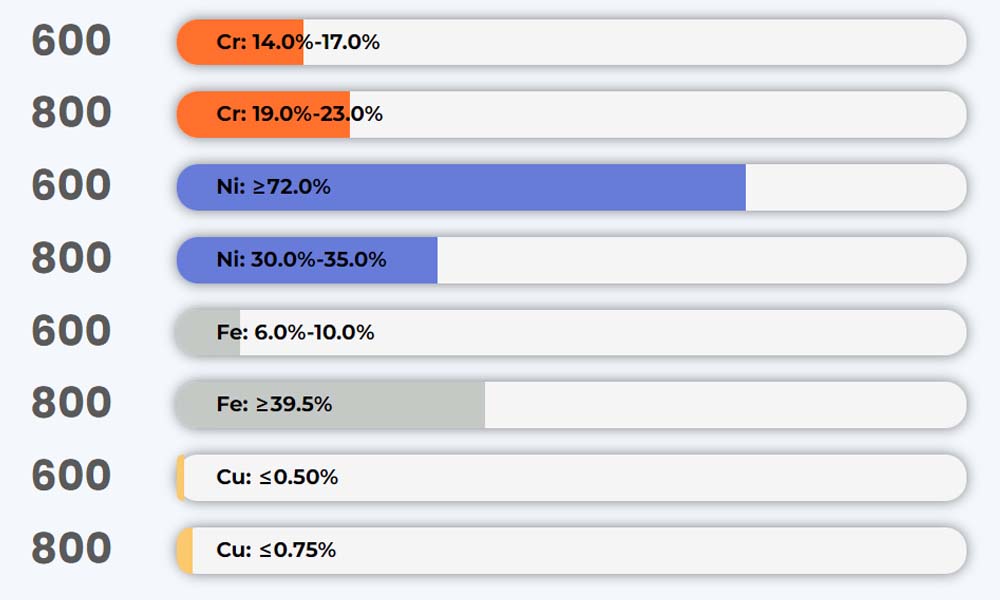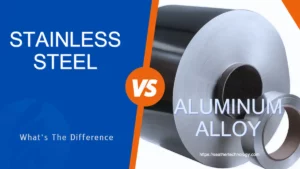Alloy 600 and alloy 800 are two frequently utilized materials classified as superalloys. Their functionalities exhibit resemblances, with both alloys catering to diverse industrial applications.
However, across all aspects, alloy 600 showcases superior performance when compared to 800. Conversely, 800 boasts a more economical cost and can serve as a substitute for 600 in certain scenarios.
Determining the suitable choice for your alloy project can be perplexing. This article aims to delineate the disparities between these two alloys, aiding you in arriving at a well-founded choice.
What is Alloy 600?
Grade alloy 600 is a standard engineering material for applications which require resistance to corrosion and heat.
The alloy also has excellent mechanical properties and presents the desirable combination of high strength and good workability.
Products Types of Alloy 600
- Alloy 600 Custom Ring
- Alloy 600 Pipe Spool
- Alloy 600 Custom Flange
- Alloy 600 Round Bar
- Alloy 600 Seamless Pipe
- Alloy 600 Welded Tube
- Alloy 600 Plate
- Alloy 600 Sheet
- Alloy 600 Strip
- Alloy 600 Wire
- Alloy 600 Foil
What is Alloy 800?
Alloy 800 is a widely used material for construction of equipment requiring corrosion resistance, heat resistance, strength, and stability for service up to 1500°F (816°C).
Alloy 800 offers general corrosion resistance to many aqueous media and, by virtue of its content of nickel, resists stress corrosion cracking.
At elevated temperatures it offers resistance to oxidation, carburization, and sulfidation along with rupture and creep strength.
Products Types of Alloy 800
- Alloy 800 Custom Ring
- Alloy 800 Pipe Spool
- Alloy 800 Custom Flange
- Alloy 800 Round Bar
- Alloy 800 Seamless Pipe
- Alloy 800 Welded Tube
- Alloy 800 Plate
- Alloy 800 Sheet
- Alloy 800 Strip
- Alloy 800 Wire
- Alloy 800 Foil
What are the Differences Between Alloy 600 and Alloy 800?
As you can see from their introduction and products types, alloy 600 and alloy 800 are very different. Depending on what you are looking for in your project, they each have benefits and drawbacks. For a side by side comparison, you breakdown the differences even further.
Chemical Composition

Corrosion Resistance
Alloy 800 provides enhanced resistance to corrosion from organic acids like formic acid or acetic acid, as well as environments containing chlorides such as seawater or brackish water.
Conversely, alloy 600 demonstrates heightened corrosion resistance against reducing acids like sulfuric or phosphoric acid, along with environments abundant in chlorides or halides.
In terms of oxidation resistance, 600 outperforms 800 in general.
Mechanical Properties
Alloy 600 Mechanical Properties
| Element | Density | Melting Point | Tensile Strength | Yield Strength (0.2%Offset) | Elongation |
| 600 | 8.47 g/cm3 | 1413 °C (2580 °F) | Psi – 95,000 , MPa – 655 | Psi – 45,000 , MPa – 310 | 40 % |
Alloy 800 Mechanical Properties
| Element | Density | Melting Point | Tensile Strength | Yield Strength (0.2%Offset) | Elongation |
| 800 | 7.94 g/cm3 | 1385 °C (2525 °F) | Psi – 75,000 , MPa – 520 | Psi – 30,000 , MPa – 205 | 30 % |
Applications
Alloy 600 Applications
- Retorts
- Muffles
- Roller hearths
- Furnace components
- Heat-treating applications
Alloy 800 Applications
- Automotive
- Electrical Resistance
- Thermal Processing
Main Standards
Alloy 600 Products Standards
- Condenser and Heat Exchanger Tube: ASTM B163
- Seamless Pipe: ASTM B167, ASTM B829
- Welded Tube: ASTM B516, ASTM B751
- Welded Fittings: ASTM B366
- Round Rod&Bar: ASTM B166
- Forgings: ASTM B564
- Plate&Sheet, Strip&Foil: ASTM B168, ASTM B906
Alloy 800 Products Standards
- Condenser and Heat Exchanger Tube: ASTM B163
- Seamless Pipe: ASTM B407, ASTM B829
- Welded Tube: ASTM B515, ASTM B751
- Welded Fittings: ASTM B366
- Round Rod&Bar: ASTM B408
- Forgings: ASTM B564
- Plate&Sheet, Foil&Strip: ASTM A240, ASTM A480, ASTM B409, ASTM B906
Cost
While 800 falls short of 600 in various aspects, its comparatively lower cost makes it a more suitable option in certain scenarios where stringent performance demands are not essential.
Therefore, the choice between the two alloys often depends on the specific requirements and budget constraints of the project or application at hand.
FAQs
What is the density of alloy 600?
Alloy 600 has a density of 8.47 g/cm3, which makes it slightly heavier than other alloys such as copper alloy or aluminium alloy, but lighter than special stainless steel or titanium alloys.
Does Alloy 600 rust?
Within the realm of nickel alloys, 600 stands out as a solid solution strengthened alloy comprised of constituents including nickel, chromium, and iron.
In particular, it does not show chloride corrosion cracking phenomenon that appears in the stainless steel.
Can Alloy 600 be welded?
Typically, there is no necessity for preheating when working with 600 for welding purposes.
However, if the temperature of the base metal falls below 15°C, it’s advisable to preheat the joint region on both sides, spanning 250 mm to 300 mm, to achieve a temperature of 15°C to 20°C. This preheating mitigates the risk of blow holes stemming from moisture condensation.
To prevent undesirable outcomes such as grain enlargement and carbide precipitation, it’s important to ensure that the inter-pass temperature doesn’t exceed 100°C.
It’s crucial to exercise caution against rapid cooling, which can lead to the formation of porosity. Thorough cleaning of the welding area before commencing the welding process is essential.
Given the limited molten flowability of nickel alloy, it’s recommended to have a sharp bevel end slope in the jointing area.
Alloy 600’s welding pool is relatively shallow, potentially resulting in incomplete penetration. Optimal results are achieved with moderate welding current strength and a swift welding pace.
Considering 600’s high coefficient of linear thermal expansion and susceptibility to hot cracking, meticulous control over heat input during welding is paramount.
What is the density of Alloy 800?
The density of 800 is also high with 7.94g/cm³
Is alloy 800 stainless steel?
Categorized as a super austenitic stainless steel, the 800 alloy comprises nickel, chromium, and iron as its foundational components, enriched with supplementary elements like molybdenum, copper, nitrogen, and silicon.
Broadly speaking, 800 tends to carry a higher price tag than regular stainless steel due to its more intricate manufacturing process. Nonetheless, this increased expense can be balanced by the advantage of reduced maintenance needs when compared to stainless steel, courtesy of its superior corrosion resistance attributes.
What is the equivalent of alloy 800?
800 equivalent is UNS N08800 and W.Nr. 1.4876.
Is 600 Better Than alloy 800?
Alloy 800 is mainly used for applications with temperatures up to 1100° F. The chemical balance makes the nickel steel alloy exhibit excellent resistance to carburization, oxidation and nitriding atmosphere.
In summary, it can be seen that 600 has a higher operating temperature than Incoloy 800, but the cost is also higher. The 800 came after the 600 and was a low-cost alternative to the 600.
Conclusion
600 alloy and alloy 800 both quality superalloys, but their suitability in different environments sets them apart.
Choosing the optimal material depends on the specific application requirements, which must be carefully evaluated before making a decision.
At Seather, we are equipped to manufacture 600 and alloy 800 related products tailored to your exact specifications.
Contact our expert team today for your nickel alloys project.






